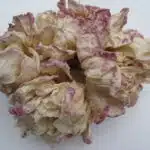Hibiscus is a genus of flowering plants that are native to tropical regions. It is grown for its beautiful flowers and is commonly used as an ornamental plant in gardens and landscapes. The ‘Perfect Storm’ Hibiscus is one of the most sought-after varieties among horticultural enthusiasts due to its unique characteristics and stunning blooms.
If you’re planning to grow and care for ‘Perfect Storm’ Hibiscus, it’s important to understand the requirements of this plant. From proper planting techniques to watering schedules, there are several key factors that can influence the growth and health of your hibiscus. In this article, we’ll explore the best practices for growing and caring for ‘Perfect Storm’ Hibiscus, so you can enjoy their beauty in your garden or landscape for years to come.
Understanding The ‘Perfect Storm’ Hibiscus
The ‘Perfect Storm’ hibiscus is an exceptional plant known for its striking beauty and unique characteristics. This hybrid cultivar is a result of cross-breeding two different hibiscus species and has inherited the best traits from both parents. The name ‘Perfect Storm’ reflects its astounding appearance, with large, ruffled flowers in shades of pink, red, and white that bloom from summer through fall.
One of the most attractive plant characteristics of ‘Perfect Storm’ hibiscus is its glossy green foliage, which provides a stunning backdrop to the vibrant blooms. The leaves are ovate and serrated, adding to the plant’s overall appeal. Additionally, this variety is relatively compact compared to other hibiscus species, making it an ideal choice for small gardens or container planting.
If you’re considering growing ‘Perfect Storm’ hibiscus in your garden, it’s essential to understand its ideal climate conditions. This cultivar thrives in full sun exposure but can also tolerate partial shade. It prefers well-draining soil that’s consistently moist but not waterlogged. In terms of temperature, it does best in USDA zones 9-11 but can also grow in zone 8 with proper care and protection during winter months. With these conditions met, your ‘Perfect Storm’ hibiscus will flourish and reward you with stunning blooms year after year.
With the right knowledge about plant characteristics and ideal climate conditions for the ‘Perfect Storm’ hibiscus, you’re now ready to move on to choosing the right location for this beautiful plant.
Choosing The Right Location For Your Plant
Understanding the ‘Perfect Storm’ Hibiscus is crucial before growing and caring for this plant. This hybrid has been bred to showcase larger and more vibrant blooms, making it a favorite among gardeners. It requires a lot of attention, care and proper maintenance to achieve the desired results.
When it comes to choosing the right location for your ‘Perfect Storm’ Hibiscus, sun exposure should be your primary consideration. The plant prefers full sun and requires at least six hours of direct sunlight daily. Insufficient sunlight may result in poor growth and fewer blooms. Additionally, ensure that there are no trees or large bushes around the area that can block the sunlight.
Drainage considerations are also essential when planting and growing this hibiscus variety. The soil needs to be well-draining to prevent waterlogging, which can lead to root rot. You can achieve good drainage by mixing organic matter like compost with garden soil or using raised beds. Ensure that you keep an eye on the moisture levels in the soil by checking it regularly with a moisture meter or by feeling it with your fingers.
Moving on from choosing the right location for your ‘Perfect Storm’ Hibiscus, you need to prepare the soil correctly and use appropriate planting techniques for optimal growth.
Soil Preparation And Planting Techniques
Hibiscus plants are known as ‘perfect storm’ and require specialized soil preparation and planting techniques for successful growth. Soil selection is important and should be chosen based on the specific needs of the ‘perfect storm’ hibiscus. The soil should be well-draining with a neutral pH and rich in organic matter. Fertilizing should be done on a regular basis with a balanced fertilizer to ensure adequate nutrition. Planting depth is also essential and the ‘perfect storm’ hibiscus should be planted at the same level as it was in the original container. Finally, mulch should be applied to keep roots cool and retain moisture.
Soil Selection
Proper soil selection is crucial for the growth and development of ‘perfect storm’ hibiscus. To ensure optimal growth, it is essential to conduct a soil test before planting. This will help in determining the pH level, nutrient content, and water retention capacity of the soil. Based on the results, appropriate amendments can be added to achieve the ideal growing conditions.
Organic amendments such as compost, manure, and peat moss can enhance soil fertility and structure. They improve water retention capacity, which is vital for hibiscus as they require constant moisture during their growth period. These organic materials also aid in retaining nutrients in the soil and release them gradually over time. Incorporating these organic amendments will ensure that your ‘perfect storm’ hibiscus has access to all necessary nutrients required for optimal growth.
It is important to note that ‘perfect storm’ hibiscus prefer well-draining soils with a pH range of 6.0-7.5. In addition to adding organic amendments, one can also incorporate perlite or vermiculite into the soil mix to improve drainage. Adequate drainage is necessary to prevent waterlogging, which can lead to root rot and other fungal diseases. By selecting the right type of soil and incorporating appropriate amendments, your ‘perfect storm’ hibiscus will have a healthy foundation for optimal growth and blooming potential.
Fertilizing
To ensure the growth and development of healthy ‘perfect storm’ hibiscus, proper soil preparation is crucial. While selecting the right type of soil and incorporating organic amendments can provide an excellent foundation for optimal growth, fertilizing is also essential to provide necessary nutrients. Fertilizer frequency and type are critical factors that need to be considered when fertilizing hibiscus.
Fertilization should begin after planting, once the plant has established itself in the soil. Applying fertilizer too early can lead to root burn and stunt the plant’s growth. Organic fertilizers such as compost or well-aged manure are excellent options for hibiscus. They release nutrients gradually into the soil, providing a steady supply of nutrients throughout the growing season. Synthetic fertilizers are also available but should be used sparingly as they can cause salt buildup in the soil.
Fertilizer frequency will depend on several factors, including the type of fertilizer used, soil pH level, and weather conditions. For optimal growth and blooming potential, ‘perfect storm’ hibiscus require regular feeding every four to six weeks during their growing season. Fertilizing should be done early in the morning or late in the day when temperatures are cooler to prevent scorching of leaves due to fertilizer salts’ heat buildup. By following these guidelines for fertilizing ‘perfect storm’ hibiscus, gardeners can ensure healthy plants with beautiful blooms all season long.
Planting Depth
When it comes to planting ‘perfect storm’ hibiscus, proper soil preparation is crucial for optimal growth and development. However, planting depth is another critical factor that can affect the plant’s overall health and success. Gardeners must ensure that they plant their hibiscus at the optimal depth to provide the necessary nutrients and moisture for healthy growth.
The optimal planting depth for ‘perfect storm’ hibiscus is around one inch deeper than the root ball. By planting at this depth, gardeners can ensure that the root system has access to sufficient moisture and nutrients from the soil while also providing stability for the plant. Planting too shallow can lead to poor root development, while planting too deep can suffocate the roots and prevent proper nutrient uptake.
One of the most common mistakes gardeners make when planting hibiscus is not considering their plant’s specific needs. Each variety may require a different planting depth, so it’s essential to research each type before planting. By ensuring that you’re planting your ‘perfect storm’ hibiscus at the correct depth, you’ll be setting your plant up for success and a beautiful blooming season.
Watering And Fertilizing Your Hibiscus
Like the human body requires water and proper nutrition to thrive, your hibiscus also needs deep watering and slow-release fertilizers to grow into a beautiful ‘perfect storm.’ Deep watering involves saturating the roots of the plant with an adequate amount of water. This method encourages healthy root growth, which is critical for the overall health and strength of the hibiscus.
To know when to water your hibiscus, check the soil’s moisture level by sticking your finger about two inches deep into the soil. If it feels dry, it’s time to water your plant. During hot summer months, you may need to water your hibiscus more frequently than usual. However, make sure not to overwater as this could lead to root rot.
Fertilizing your hibiscus is equally important. Slow-release fertilizers are ideal for a continuous supply of nutrients without burning or harming the plant. Apply fertilizer every four weeks during the growing season (spring through fall). Be sure to follow package instructions for specific amounts needed per pot size. With proper watering and fertilizing techniques, your hibiscus will flourish with vibrant blooms that will brighten up any garden or landscape.
As important as watering and fertilizing are for optimal growth, pruning and deadheading play a crucial role in maintaining a healthy ‘perfect storm’ hibiscus. Regular pruning helps shape your plant and remove any dead or diseased branches that can hinder growth or attract pests. Deadheading spent blooms encourages new flower growth while preventing seed production that can weaken future blooming cycles. In the next section, we will discuss pruning and deadheading techniques you can apply to keep your ‘perfect storm’ in top shape year-round.
Pruning And Deadheading For Optimal Growth
To keep your ‘Perfect Storm’ Hibiscus looking healthy and vigorous, you need to implement proper pruning techniques and deadheading frequency. Pruning is essential for maintaining the shape of the plant and removing any damaged or diseased growth. Deadheading promotes continuous blooming by removing spent flowers before they can form seeds, which would cause energy to be diverted from flower production to seed production. Both pruning and deadheading should be done regularly throughout the growing season.
When pruning your hibiscus, it’s important to use sharp, clean tools to prevent damaging the plant or spreading disease. Start by removing any dead or diseased branches, cutting them back to healthy tissue. Next, remove any branches that are crossing or rubbing against each other. If your hibiscus has grown too large or is misshapen, you can cut it back by up to one-third of its height in the spring when new growth appears. Regular pruning will keep your hibiscus looking neat and tidy while promoting healthy growth.
Deadheading should be done as soon as flowers fade, cutting just below the spent bloom. This will encourage more blooms to form and extend the flowering season. If left unattended, spent blooms will produce seeds that take away from energy needed for further blooming. Deadheading every week or two throughout the growing season is ideal for optimal results.
Proper pruning techniques and consistent deadheading frequency are essential for maintaining healthy growth in your ‘Perfect Storm’ Hibiscus. By following these steps regularly throughout the growing season, you’ll enjoy a beautiful display of vibrant blooms all summer long. In our next section, we’ll discuss managing pests and diseases that can affect hibiscus plants.
Managing Pests And Diseases
Effective pest and disease management is crucial for the health and growth of ‘perfect storm’ hibiscus. Integrated pest management (IPM) is a holistic approach to managing pests and diseases that involves using multiple strategies to prevent, monitor, and control them. IPM emphasizes prevention as the first line of defense against pests and diseases, which includes cultural practices such as proper watering, fertilization, pruning, and sanitation.
One natural remedy for controlling pests on ‘perfect storm’ hibiscus is neem oil. Neem oil is derived from the seeds of the neem tree and has insecticidal properties that can help control aphids, whiteflies, spider mites, and other common pests. To use neem oil, mix it with water according to the manufacturer’s instructions and spray it onto the foliage of affected plants. Repeat every 7-10 days or as needed until pests are under control.
Another natural remedy for preventing fungal diseases on ‘perfect storm’ hibiscus is compost tea. Compost tea is made by steeping compost in water until it becomes a concentrated liquid fertilizer that contains beneficial microorganisms that can protect plants against fungal diseases. To make compost tea, fill a bucket with water and add a shovelful of compost. Let it steep for 24 hours before straining out the solids and diluting it with additional water if necessary. Apply the compost tea to the soil around the base of your plants every 2-4 weeks during the growing season.
To propagate ‘perfect storm’ hibiscus successfully, there are several methods you can try such as stem cuttings or air layering. Stem cuttings are taken from healthy mature plants in late spring or early summer when new growth is emerging. Cut off a section of stem about 6 inches long just below a leaf node and remove all but two or three leaves at the top of the cutting. Dip the cut end in rooting hormone and plant it in a well-draining potting mix. Keep the soil moist and warm, and your cutting should root in about 4-6 weeks.
Propagation Methods For ‘Perfect Storm’ Hibiscus
When it comes to propagating ‘Perfect Storm’ Hibiscus, there are various techniques that one can use. One of the most common methods is through stem cuttings. To propagate this plant using stem cutting, it is essential to select healthy stems from the parent plant and cut them at an angle just below a node. The cutting should be around 4-6 inches long and have at least two leaves attached. The lower leaves should be removed, and the cutting should be soaked in rooting hormone before planting.
Another technique for propagating ‘Perfect Storm’ Hibiscus is through layering. This method involves bending a low growing branch towards the ground and then covering it with soil. A small portion of the branch should be exposed above the soil level so that it can continue receiving sunlight. After some time, roots will develop from the covered portion of the branch, and a new plant will emerge.
When selecting planting materials for propagating ‘Perfect Storm’ Hibiscus, it is crucial to choose well-draining soils with high fertility levels. It is recommended to mix perlite or vermiculite into the soil to enhance drainage properties further. Moreover, using sterile tools when taking cuttings or layering will help prevent infections from spreading while promoting faster root development.
Moving on to winter care and protection for ‘Perfect Storm’ Hibiscus, there are specific measures one can take to ensure that their plants survive through harsh weather conditions.
Winter Care And Protection
After successfully propagating your ‘Perfect Storm’ hibiscus, it is important to consider its winter care and protection. Due to its tropical nature, this plant is susceptible to frost damage, which can cause wilting and leaf drop. To prevent this, it is recommended to place your hibiscus in a sheltered area during the winter months or bring it indoors if possible.
In addition to frost prevention, it is important to provide adequate moisture for your ‘Perfect Storm’ hibiscus during the winter season. While it may not require as much water as during the growing season, make sure the soil does not dry out completely. You can also add a layer of mulch around the base of the plant to help retain moisture and protect the roots from freezing temperatures.
If you notice any issues with your hibiscus during the winter months, such as yellowing leaves or stunted growth, there may be some common problems that need troubleshooting. These can include overwatering or underwatering, pest infestations, or nutrient deficiencies. By addressing these issues promptly and providing proper care, you can ensure that your ‘Perfect Storm’ hibiscus will thrive year-round.
Troubleshooting Common Problems
One of the most frustrating things for any gardener is when your plants begin to suffer from common problems. While growing and caring for your ‘perfect storm’ hibiscus can be a rewarding experience, it’s important to know how to troubleshoot common issues that may arise.
Pest prevention is a crucial aspect of maintaining healthy plants. Some common pests that may affect your hibiscus include aphids, spider mites, and whiteflies. To prevent these pests from infesting your plant, keep the area around the plant clean and free of debris. Additionally, you can use natural pest control methods such as introducing ladybugs or spraying neem oil on the leaves.
Nutrient deficiencies are also a common issue that can cause problems with your hibiscus. If you notice yellowing leaves or stunted growth, it may be a sign of nutrient deficiency. To prevent this, make sure you’re providing your plant with adequate nutrients through fertilization. A balanced fertilizer with equal parts nitrogen, phosphorus, and potassium is ideal for hibiscus plants.
Now that you know how to troubleshoot common problems with your ‘perfect storm’ hibiscus, you can enjoy its stunning beauty without worry. In the next section, we’ll discuss some tips for enjoying the full potential of your plant by maximizing its growth and flowering potential.
Enjoying The Beauty Of Your ‘Perfect Storm’ Hibiscus
Creating stunning displays with your ‘Perfect Storm’ Hibiscus is easy when you follow proper care techniques. With its beautiful flowers and unique color patterns, this hibiscus variety can brighten up any garden or landscape. To maximize bloom time, make sure to give your plant the proper amount of sunlight, water, and nutrients.
One way to create a stunning display is by planting your hibiscus in a group with other colorful plants that have different blooming periods. This will provide a continuous display of colors throughout the year. Another option is to plant in containers and mix with other varieties of hibiscus or tropical plants for an exotic look.
To further enhance the beauty of your ‘Perfect Storm’ Hibiscus, deadhead regularly and prune back after each blooming period to encourage new growth. Using a high-quality fertilizer specifically formulated for hibiscus will also help promote healthy growth and increase bloom production. With consistent care, your ‘Perfect Storm’ Hibiscus will thrive and provide endless enjoyment for years to come.
| Care Tips | Frequency | Additional Notes |
|---|---|---|
| Watering | Once per week | Keep soil slightly moist |
| Fertilizing | Every 4-6 weeks | Use a balanced formula |
| Sunlight | Full sun to partial shade | Protect from harsh afternoon sun |
Remember that caring for your ‘Perfect Storm’ Hibiscus requires patience and dedication but the results are well worth it. By following these simple tips, you can enjoy the beauty of this stunning plant all season long. Serve yourself by creating a beautiful oasis in your garden or landscape that others can admire as well.
Conclusion
The ‘Perfect Storm’ Hibiscus is an exquisite addition to any garden with its deep red blooms and unique variegated foliage. To ensure optimal growth and beauty, it is important to choose the right location for your plant, prepare the soil properly, water and fertilize regularly, prune and deadhead as necessary, propagate using appropriate methods, and provide winter care and protection.
When choosing a location for your ‘Perfect Storm’ Hibiscus, consider factors such as sunlight exposure, soil quality, and drainage. The soil should be well-draining with a pH level between 6.0 and 7.5. Fertilize every two weeks during the growing season with a balanced fertilizer high in phosphorus.
Proper pruning techniques will help to maintain the shape of the plant while removing any dead or damaged branches. Deadheading will encourage more blooms and prevent seed formation which can lead to decreased blooming. Propagation can be done through stem cuttings or division of the root ball.
In conclusion, growing and caring for ‘Perfect Storm’ Hibiscus requires dedication and effort but the results are truly worth it. As horticulturalists say, “patience is a virtue” when it comes to nurturing plants into their full potential. With proper care and attention, you can enjoy the beauty of this stunning plant in your garden year after year.
Image Credits
- “Yellow Hibiscus, taken in my garden” by Ray in Manila (featured)





























